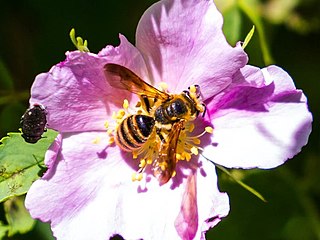Triepeolus grandis is a species of cuckoo bees in the family Apidae. It is found in the United States and Mexico.

Triepeolus is a genus of cuckoo bees in the family Apidae. There are at least 140 described species in Triepeolus. The majority of species whose life history is known are kleptoparasitic in the nests of bees in the tribe Eucerini, especially the genera Melissodes and Svastra.
Stictiella is a genus of sand wasps in the family Crabronidae. There are at least 14 described species in Stictiella.
Stictiellina is a subtribe of wasps in the family Crabronidae. There are at least 60 described species in Stictiellina.
Conanthalictus is a genus of sweat bees in the family Halictidae. There are about 13 described species in Conanthalictus.

Tromatobia is a genus of ichneumon wasps in the family Ichneumonidae. There are at least 4 described species in Tromatobia. Species in this genus are parasites of egg sacs of spiders from the families Araneidae, Clubionidae, Philodromidae and Theridiidae.

Taxonus is a genus of common sawflies in the family Tenthredinidae. There are about 8 described species in Taxonus.

Dufourea is a genus of sweat bees in the family Halictidae. There are at least 160 described species in Dufourea.

Echthrus is a genus of ichneumon wasps in the family Ichneumonidae.

Dianthidium is a genus of leafcutter, mason, and resin bees in the family Megachilidae. There are at least 20 described species in Dianthidium.

Stelis is a genus of kleptoparasitic cuckoo bees in the family Megachilidae. There are at least 100 described species in Stelis.
Stizoides foxi, or Fox's stizoide, is a species of sand wasp in the family Crabronidae. It is found in Central America and North America.

Stizoides is a genus of kleptoparasitic sand wasps in the family Crabronidae. There are at least 30 described species in Stizoides.

The golden-haired miner bee is a species of miner bee in the family Andrenidae. The female bees are 8 to 10 mm in length, and males are 6 to 9 mm long. It is found in the western United States, and is relatively rare outside California. It looks very similar to the death camas miner bee but is smaller.
Epinysson basilaris is a species of insect in the family Crabronidae. It is found in Central America and North America.

Hoplisoides is a genus of sand wasps in the family Crabronidae. There are at least 70 described species in Hoplisoides.
Steniolia scolopacea is a species of sand wasp in the family Crabronidae. It is found in Central America and North America.

Coelioxys banksi is a species of leafcutter bees in the family Megachilidae. It is a parasite of Megachile relativa nests.
Glenostictia is a genus of sand wasps in the family Crabronidae. There are more than 20 described species in Glenostictia.
Agathis is a genus of braconid parasitoid wasps. This genus was established by Latreille in 1804, and the type species is Agathis malvacearum Latreille, 1805. There are at least forty six species of Agathis in the western palearctic region.











